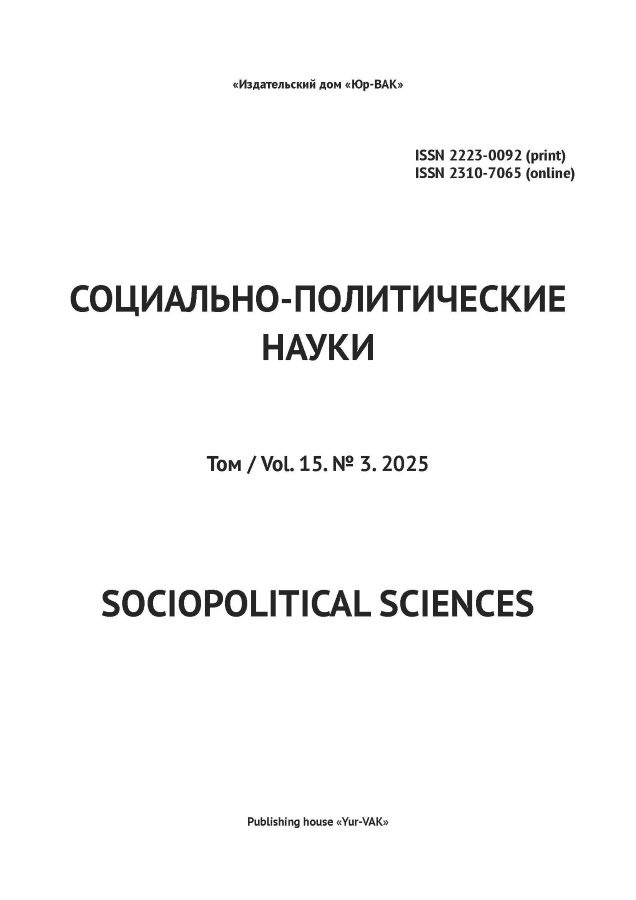Political Network as an Infrastructure of Integration: The EAEU Between Formal Institutions and Informal Influence
- Authors: Kurochkin A.V.1, Taranets V.A.1
-
Affiliations:
- Patrice Lumumba Peoples’ Friendship University of Russia
- Issue: Vol 15, No 3 (2025)
- Pages: 59-65
- Section: Political Institutions, Processes and Technologies
- URL: https://journals.eco-vector.com/2223-0092/article/view/687839
- DOI: https://doi.org/10.33693/2223-0092-2025-15-3-59-65
- EDN: https://elibrary.ru/RQGOZH
- ID: 687839
Cite item
Abstract
The article explores the role of political networks in the functioning of the Eurasian Economic Union (EAEU) through the conceptual lens of network as infrastructure. The author puts forward the hypothesis that informal interactions between political actors act as infrastructural compensatory mechanisms in the context of institutional vulnerability and fragmentation. The theoretical framework draws upon Actor-Network Theory, Manuel Castells’ network society concept, and infrastructure sociology (S.L. Star). Particular attention is paid to the case of China-Kazakhstan relations, which demonstrates how an external informal network can reshape the internal structure of a regional organization. The article presents a conceptual analysis of actors, levels of network interaction (formal and informal), types of ties, and coordination architecture within the EAEU. It concludes that the network does not merely complement institutions but rather functions as an alternative governance infrastructure in a weakly institutionalized integration setting. The work contributes to a theoretical and analytical understanding of post-Soviet integration in Eurasia and provides a foundation for further empirical research.
Keywords
Full Text
About the authors
Alexander V. Kurochkin
Patrice Lumumba Peoples’ Friendship University of Russia
Author for correspondence.
Email: kurochkin-alvch@rudn.ru
ORCID iD: 0000-0003-4675-3625
SPIN-code: 1065-8853
Dr. Sci. (Polit.); Professor at the Department of Comparative Politics
Russian Federation, MoscowVyacheslav A. Taranets
Patrice Lumumba Peoples’ Friendship University of Russia
Email: slavataranec@gmail.com
ORCID iD: 0009-0009-4361-9683
SPIN-code: 8211-5004
Postgraduate Student at the Department of Comparative Politics
Russian Federation, MoscowReferences
- Kalachigin G.M. The Russian Far East and integration with Asia: Tuning connectivity. Issues of Geography. 2023. No. 148. Pp. 210–227. (In Rus.)
- Likhachyova A.B. On the strategic effects of unilateral sanctions: The Russian experience. Financial Journal. 2021. No. 4. Pp. 52–66. (In Rus.)
- Minasyan G.M. New aspects of Eurasian integration: The EAEU experience. Bulletin of Kemerovo State University. 2023. Vol. 25. No. 2. Pp. 244–251. (In Rus.)
- Adarov A. Eurasian economic integration: Impact evaluation using the gravity model and the synthetic control methods. Review of World Economics. 2023. Vol. 159. No. 2. Pp. 467–504. doi: 10.1007/s10290-022-00473-2.
- Bakumbayev B. Small state as order-maker: The case of Kazakhstan’s Eurasian Union project. Post-Soviet Affairs. 2025. Vol. 41. No. 3. Pp. 219–241. doi: 10.1080/1060586X.2025.2486892.
- Castells M. The rise of the network society. 2nd ed. Oxford: Wiley-Blackwell, 2010. 656 p.
- Hakhverdyan D., Tadevosyan R., Pakhlyan A., Ratner S. The impact of Eurasian Economic Union membership on mutual trade in services: What are the challenges for small economies? Journal of Risk and Financial Management. 2025. Vol. 18. No. 3. Art. 143. doi: 10.3390/jrfm18030143.
- Libman A. The rise and fall of the Eurasian regionalism. The Economists’ Voice. 2023. Vol. 20. No. 2. Pp. 267–274. doi: 10.1515/ev-2023-0041.
- Mikhaliova T., Vasilevich G. Integration political and legal analysis of dispute resolution and prospects for digitalization of justice in the Eurasian Economic Union. WISDOM. 2023. Vol. 28. No. 4. Pp. 190–200. doi: 10.24234/wisdom.v28i4.1089.
- Star S.L., Bowker G.C. Sorting things out: Classification and its consequences. Cambridge, MA: MIT Press, 2000. 377 p.
Supplementary files









